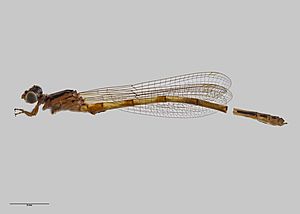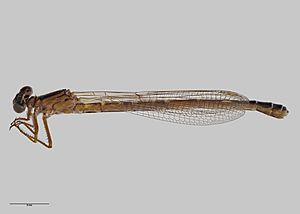Red damselfly facts for kids
Quick facts for kids Red damselfly |
|
|---|---|
 |
|
| A male holotype specimen at the Auckland War Memorial Museum. | |
 |
|
| A female allotype specimen at the Auckland War Memorial Museum. | |
| Scientific classification |
The Xanthocnemis zealandica, often called the red damselfly or red coat damselfly, is a small, colorful insect. It is the most common native damselfly found in New Zealand. You can often spot adult red damselflies flying near plants close to streams and other water bodies.
These damselflies are part of a group of insects called Odonata, which also includes dragonflies. Red damselflies are known for their bright red bodies, especially the males. They are an important part of New Zealand's freshwater ecosystems.
Contents
What is a Red Damselfly?
Red damselflies are slender insects with two pairs of clear wings. They are often mistaken for dragonflies, but there are key differences. Damselflies usually hold their wings together over their back when resting. Dragonflies, however, typically hold their wings out to the sides.
The red damselfly gets its name from its striking color. Males are usually bright red, while females can be red, brown, or even black. Their long, thin bodies help them move quickly through the air.
Where Do Red Damselflies Live?
Xanthocnemis zealandica is found all over New Zealand. They prefer habitats with fresh water. This includes rocky streams, slow-moving rivers, and even ponds. They need water that is clean enough for their young to grow.
You will often see them in areas with lots of plants near the water. These plants provide places for them to rest and hunt. They are a common sight in many parts of the New Zealand countryside.
The Life Cycle of a Red Damselfly
Like many insects, the red damselfly goes through several stages in its life. This process is called metamorphosis. It starts as an egg, then becomes a larva, and finally turns into an adult. Most of their life is spent underwater.
Eggs and Larvae
Female damselflies lay their eggs in or near water. They often place them on underwater plants. Once the eggs hatch, tiny creatures called larvae (or nymphs) emerge. These larvae live entirely underwater.
Red damselfly larvae are well-adapted to their watery home. They have special gills at the end of their tails that help them breathe. These gills look like three pointed leaves. The larvae also have long hairs near the tip of their tails.
What Do Larvae Eat?
Underwater, damselfly larvae are fierce predators. They have a special lower lip that can shoot out to catch prey. They eat other small water insects, tadpoles, and even tiny fish. They are an important part of the food web in streams and ponds.
As they grow, the larvae shed their skin multiple times. This process is called molting. Each time they molt, they get a little bigger. This stage can last for several months or even a year.
Adult Damselflies
When a larva is ready to become an adult, it crawls out of the water. It usually climbs onto a plant stem or a rock. Its skin then splits open, and the adult damselfly emerges. This is a truly amazing transformation!
The newly emerged adult damselfly is soft and pale at first. Its wings are crumpled. Over a few hours, its body hardens, and its wings expand and dry. Then, it is ready to fly and begin its adult life.
What Do Adults Eat?
Adult red damselflies are also predators. They catch and eat smaller flying insects, such as mosquitoes and flies. They are very agile flyers and can snatch their prey right out of the air. They help control insect populations.
Adult damselflies spend their time flying, hunting, and finding a mate. Their bright colors help them attract partners. After mating, the female lays her eggs, and the life cycle begins again. Adult damselflies typically live for only a few weeks.
Why Are Red Damselflies Important?
Red damselflies play a vital role in their ecosystems. As both larvae and adults, they help control populations of other insects. This includes insects that might be considered pests, like mosquitoes.
Their presence can also be a sign of a healthy environment. Since their larvae need clean water to survive, finding many red damselflies can mean the water quality is good. They are a fascinating part of New Zealand's natural heritage.

